Establishing a Pā Harakeke
A pā harakeke is a planting of selected varieties of harakeke (Phormium spp., New Zealand flax), chosen for their muka (fibre) or raranga (weaving/plaiting) qualities.
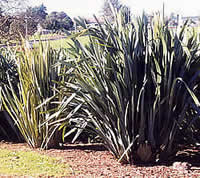
Cultivating harakeke is a way to ensure vigorous, healthy bushes that will provide high quality leaf material for weaving.
Think of the pā harakeke as a garden. Many of the same principles apply. We choose varieties that best suit the site and climate, and the weaving purposes we have in mind. We space the plants so they have room to grow, don't have to compete with other plants for their nutritional requirements, and so we can easily get to them when it's time for harvesting or pruning. Ideally, we keep the plot weed-free and use whichever means we find acceptable to control pests and diseases.
Choosing harakeke varieties
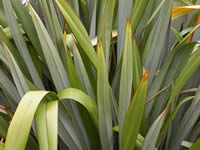 Local weavers will know which types of harakeke are best to use. Are you mostly interested in weaving kete and mats, or using muka for cloak making? Do you want to make piupiu for kapa haka groups? Are there beginners or schoolchildren needing soft-leaved bushes to practise with?
Local weavers will know which types of harakeke are best to use. Are you mostly interested in weaving kete and mats, or using muka for cloak making? Do you want to make piupiu for kapa haka groups? Are there beginners or schoolchildren needing soft-leaved bushes to practise with?
Suitable varieties may be available through the network of weavers. Another source is the Rene Orchiston Collection maintained by Manaaki Whenua at Lincoln.
Vegetative division or seed?
To ensure a plant has the same properties as the parent bush, we take a division from it (a fan with some root material attached). If we plant seeds, we can’t be sure whether the characteristics of the resulting bush will be what we want. In botanical terms, harakeke preferentially out-crosses, i.e. the pods develop best when the flower has been pollinated by pollen from a separate plant. And just like people, the progeny of two flax bushes may have different characters from their parents!
Seedlings also take longer to mature, about 6–8 years. Plants grown from root stock take about half that time.
If seedlings are desired, the seed should be chilled (put in the fridge) for 12 weeks to ensure good germination.
Choosing a site
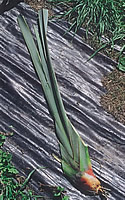 Although harakeke is found in many places and is commonly associated with swamps, the best-quality plants grow on fertile, well-drained soil. Harakeke doesn't like stagnant water around its roots, although it does not mind occasional flooding. Harakeke is very happy growing on the edge of running streams.
Although harakeke is found in many places and is commonly associated with swamps, the best-quality plants grow on fertile, well-drained soil. Harakeke doesn't like stagnant water around its roots, although it does not mind occasional flooding. Harakeke is very happy growing on the edge of running streams.
Mature plants can withstand drought, though it has a detrimental effect on the ease of stripping fibre. Harakeke is generally frost-hardy but will not withstand prolonged temperatures below freezing. Young plants, especially some of the softer-leaved varieties, are more vulnerable to both frost and dry conditions. A sunny site is preferred. Avoid growing under large trees or in too shaded an area.
Planting time
The best time for planting depends on growing conditions in your area.
Autumn/winter is a good time for transplanting, but in very cold areas, wait until spring. We generally don't transplant harakeke when the kōrari (flower stalks) are emerging, or in the dry summer months.
Preparing a site
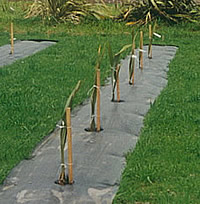 The planting area should be cleared of perennial weeds. If appropriate, use glyphosate (RoundUp®) to clear the site. In trials throughout Aotearoa, we used weed matting and found it very effective in reducing maintenance time. It had the added advantage of keeping the soil more moist. Lay the matting down first, then poke holes in it to plant the fans. Old wool carpet is also good to use, because it will rot away nicely as the harakeke grows.
The planting area should be cleared of perennial weeds. If appropriate, use glyphosate (RoundUp®) to clear the site. In trials throughout Aotearoa, we used weed matting and found it very effective in reducing maintenance time. It had the added advantage of keeping the soil more moist. Lay the matting down first, then poke holes in it to plant the fans. Old wool carpet is also good to use, because it will rot away nicely as the harakeke grows.
Planting the harakeke
Taking fans off the parent bush can be hard work! If possible, choose a time when the soil is moist. We like to use a long-bladed planting or trenching spade, a grubber, or even a crowbar to dig around and get under and behind the fan we are lifting.
Divided fans are usually trimmed of outer leaves, leaving the rito (growing shoot) and the two 'parent' leaves on either side (awhi rito or matua). The parent leaves should be cut back if too long, but it is a good idea to have some protection of the rito. If possible, plant the harakeke fans together in groups of three. This will give them a good start.
The traditional way to plant harakeke is to ‘plant the puku to the sun', so that the bulge on the fan faces halfway between the rising and setting sun. This protects the baby fans, which will emerge at the back of the clump, and gives them shade and moisture.
Allow at least two metres, preferably three, between each clump. This looks like a ridiculously large gap at first! This spacing will allow good air movement among the plants as they grow, which helps prevent build-up of scale and fungal diseases, and allows easier access for trimming and harvesting.
If the soil is poor, apply general fertiliser containing phosphate. Plants will also benefit from regular watering.
Keep a record of varieties planted
Draw a plan of the site layout and record where the different varieties are planted. It’s important to preserve the integrity of their names and whakapapa. Many harakeke look quite similar and can be easily confused.
Maintenance
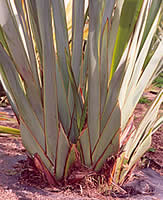 Keep the area around the base of the plants weeded and trim dead leaves. When the plants are mature they will appreciate an annual pruning. Trim each fan back to the central three leaves — the rito and the awhi rito. We usually do this in winter. Another time for pruning is when the leaves are harvested. Take the leaves required, then clean the rest of the bush. Pruning results in vigorous growth of good quality leaves and helps keep insect pests and diseases at bay.
Keep the area around the base of the plants weeded and trim dead leaves. When the plants are mature they will appreciate an annual pruning. Trim each fan back to the central three leaves — the rito and the awhi rito. We usually do this in winter. Another time for pruning is when the leaves are harvested. Take the leaves required, then clean the rest of the bush. Pruning results in vigorous growth of good quality leaves and helps keep insect pests and diseases at bay.
Use a sharp knife for cutting, not secateurs. Some weavers use a Stanley knife, with snap-off blades. Cut the leaves on an angle at the base of the fan. This is to ensure that water flows to the ground and doesn’t rot the new growth. It’s also safer not to have sharp blades sticking out where they can jab people working around the bush.
Some weavers prefer to cut off the kōrari when they emerge, so that the plant's energy goes into leaf growth rather than flowering. If a pā harakeke of ‘imported’ varieties is planted close to wild plants, cutting off the kōrari also ensures that there is no seed contamination of local types. However, the flowers are a wonderful source of nectar for birds, especially tūī.
Traditionally, old leaves and weaving scraps were placed back under the parent bush. Nowadays, it is best not to do this. This material provides a home for the insects that chew the harakeke leaves (see below). Keep the bushes clear of dead leaves, weeds and debris.
Harvesting harakeke
Local weavers will know the tikanga for your area. Generally, harakeke is not harvested when the kōrari are growing. Harakeke should not be gathered in the rain. Most important of all, don't ever harvest the central three leaves of a fan.
